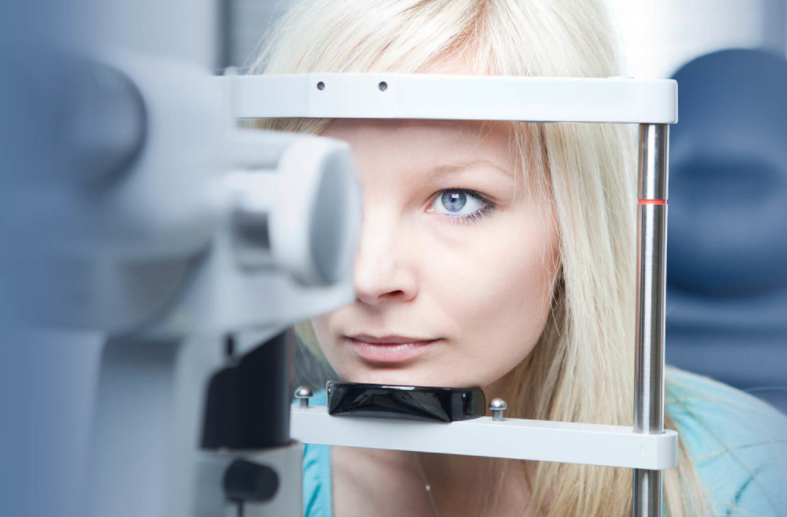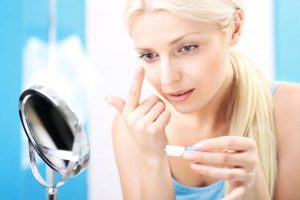Over 22 percent of people who wear eyeglasses enjoy the benefits of also using contact lenses.
If you are thinking about contact lenses, a contact lens exam will allow your eye doctor to determine if you are suitable for contact lens wear.
Regular comprehensive eye examinations include tests for visual acuity and ocular health. While these tests will help to determine if you require vision correction, they do not include the specialized tests necessary for a contact lens prescription.
A contact lens examination includes specific tests to determine your candidacy for contact lenses, as well as the necessary measurements to determine an optimal contact lens prescription.
During this specialized exam, your eye doctor may also inquire about your lifestyle and any preferences you may have regarding the type of lenses you are interested in— soft lenses, rigid gas permeable lenses, bifocals, multifocals, dailies, bi-weeklies, monthlies, or extended wear options.
What to expect during a contact lens exam?
Contact lenses are specially designed to fit the unique curvature and size of your eye.
The contact lens design will ensure that they sit comfortably on your cornea, the outer clear surface of your eye. If your contact lenses don’t fit properly, you may experience blurry vision or discomfort— you may even put your eye at risk of corneal abrasion or infection.
Therefore, it is important to obtain accurate measurements of your optical prescription, corneal shape, size, curvature, and even the quality of your tears.
The following tests may be conducted to obtain a precise contact lens prescription:
1. Cornea size and curvature. This test enables your eye doctor to determine an appropriate size and base curve for your contact lenses.
Your eye doctor will use an instrument called a keratometer to examine how light reflects off of your cornea, in order to obtain the base curve of your cornea.
Your eye doctor may also use an instrument called a corneal topographer for a more accurate measurement, as the keratometer can only measure a small area of the cornea.
The corneal topography test will provide color-coded details about your entire cornea, including its surface, by analyzing how light emitted from the device reflects off of your cornea.
During the test, you will sit in front of a lighted bowl that contains a pattern of rings, and rest your head against a curved bar. A series of data points will be collected, and a color coded “map” or image of your corneal shape will be generated on a computer screen.
Using both of these tests, your eye doctor can determine if you have an astigmatism, causing an irregular corneal shape. If an astigmatism is present, you may be a candidate for a special type of lens, called a toric lens.
2. Pupil or iris size. Your eye doctor may also measure the size of your eye’s pupil or iris to determine which size contact lenses are most appropriate for you. This is especially important if you plan to wear rigid gas permeable lenses.
This test can be performed by holding a ruler or card containing different pupil sizes close to your eye to discover the closest match. Another way to perform this test is to hold a pupil gauge next to your eye to obtain a close estimation of your pupil size.
The most accurate way of measuring pupil size is to use an automated instrument. An automated instrument will not only provide an exact pupil measurement, but also the horizontal and vertical diameter of your pupil.
To obtain a precise measurement of your eye’s iris, your eye doctor may use similar techniques.
3. Tear film evaluation. This test will be an important determining factor of your ability to successfully wear contact lenses. Dry eyes can significantly affect contact lens wear, as it can cause your eyes to become irritated and itchy, making it difficult to wear your lenses.
If you have severe dry eyes, or dry eye syndrome, your eye doctor may recommend avoiding contact lenses. However, if you have mild dry eyes, your eye doctor can prescribe contact lenses that are specially designed for dry eyes.
To determine if you have a dry eye problem, your eye doctor may place a special strip of paper under your lower eyelid. You will be asked to close your eyes for five minutes as your tears collect on the paper. Your doctor will then measure and analyze the amount of tears produced along the length of paper.
Another dry eye test involves inserting eye drops containing fluorescein dye into your tear film and measuring the amount of time it takes for your tears to evaporate.
If you would like to enjoy the benefits of contact lenses, contact an eye doctor near you.
SEE RELATED: Soft Contacts: Dailies or Monthlies?
Contact lens trial fitting
Once all of the necessary measurements are taken, your eye doctor will place ‘trial’ lenses on your eyes, to assess their comfort and fit.
These trial lenses will be worn for several minutes to allow the lenses to interact with your tears and corneal shape. Your eye doctor will then examine the appearance and comfort of these lenses, as well as your visual acuity.
Several trials of various lenses may be required until your optometrist finds the most appropriate lens for you.
Contact lens education
Contact lenses require special care and proper handling to ensure that they remain clean and safe for use.
Your eye doctor will provide clear instructions on how to care for and handle your contact lenses, and teach you how to properly insert and remove a contact lens from your eye.
At the end of your exam, you will be given trial contact lenses with your prescription to wear for the next week. Most eye doctors recommend returning after one week for a follow up evaluation, to check how your eyes are adjusting to the contact lenses.
What is in my contact lens prescription?
Once it has been determined that your contact lenses are a proper fit, your eye doctor will give you a prescription to order your new contact lenses.
The prescription will include the brand name or material of the lenses, your lens power, base curve, and diameter measurements.
Toric lenses, prescribed for astigmatism, will also include a cylinder power and axis.
Many eye doctors will order your contact lenses for you directly from the manufacturer. This will ensure that the lenses arrive safely and correctly match your prescription.
What to expect during a follow up exam
Follow up visits with your eye doctor are essential for maintaining your eye health.
A follow up visit generally involves an evaluation of your cornea to detect any changes caused by your new contact lenses.
An instrument called a slit lamp will be used to examine your cornea and other ocular tissues, under high magnification. The slit lamp will also help your eye doctor to assess how well your contact lenses fit, as the magnification enables a clear view of the alignment of the lens as it sits on your cornea.
Eye drops with fluorescein dye may also be used for further evaluation, and to check for any corneal damage that may have been caused by the lenses.
If you encounter any contact lens or eye discomfort before your next exam, contact your eye doctor as soon as possible.
Developing a close relationship with your optometrist is the best way to ensure years of successful contact lens wear.
LEARN MORE: Optical and Contact Lenses
A contact lens exam is the first step to achieving clear and comfortable vision, without the need for eyeglasses. Schedule your exam today!


